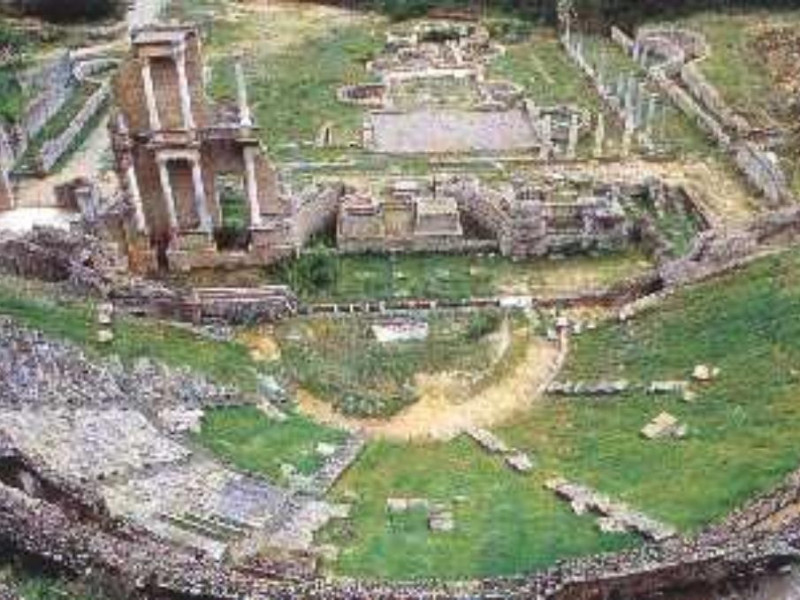Destinazioni - Comune
Volterra
Where
Volterra (Pisa)
Volterra, known to the ancient Etruscans as Velathri, to the Romans as Volaterrae, is a town and comune in the Tuscany region of Italy.
History
The town was a Neolithic settlement and an important Etruscan center (Velathri or Felathri in Etruscan, Velàthre, Βελάθρη in Greek) with an original civilization. The site is believed to have been continuously inhabited as a city since at least the end of the 8th century BCE. It became a municipium in the Roman Age. The city was a bishop's residence in the 5th century, and its episcopal power was affirmed during the 12th century. With the decline of the episcopate, Volterra became a place of interest of the Florentines, whose forces conquered Volterra. Florentine rule was not always popular, and opposition occasionally broke into rebellion. These rebellions were put down by Florence.
Notable citizens included:
Persius, the Roman satirist of Etruscan stock; possibly
Lucius Petronius Taurus Volusianus, consul with the Emperor Gallienus in AD 261 and Urban Prefect in AD 267-8; and
The Mannerist painter Daniele da Volterra.
The poet Jacopo da Leona was a judge at Volterra in the 13th century.
When the Florentine Republic fell in 1530, Volterra came under the control of the Medici family and later followed the history of the Grand Duchy of Tuscany.
Points of interest
Roman Theatre (1st century BC), excavated in the 1950s.
Piazza dei Priori
Palazzo dei Priori. Begun in 1208 and finished in 1257.
Pinacoteca (Art Gallery) in Palazzo Minucci-Solaini. The Gallery was founded in 1905 and consists mostly of works by Tuscan artists from 14th to 17th centuries. Includes a Deposition by Rosso Fiorentino.
Volterra Cathedral. It was enlarged in the 13th century after an earthquake. It houses a ciborium and some angels by Mino da Fiesole, a notable wood Deposition (1228), a masterwork of Romanesque sculpture and the Sacrament Chapel, with paintings by Santi di Tito, Giovanni Balducci and Agostino Veracini. In the center of the vault are fragments of an Eternal Father by Niccolò Circignani. Also noteworthy is the Addolorata Chapel, with a terracotta group attributed to Andrea della Robbia and a fresco of Riding Magi by Benozzo Gozzoli. In the nearby chapel, dedicated to the Very Holy Name of Jesus, is a table with Christ's monogram, allegedly painted by Bernardino of Siena. The rectangular bell tower is from 1493.
Medicean Fortress (Maschio), now a prison housing a noted restaurant.
Guarnacci Etruscan Museum, with thousands of funeral urns dating back to the Hellenistic and Archaic periods. Main attractions are the bronze statuette "Shadow of the Night" and the sculpted effigy of an Etruscan couple in terra cotta.
The Etruscan walls, including the well-preserved Porta dell'Arco (3rd-2nd centuries BC) and Porta Diana gates.
Outside the city, in direction of Lajatico, is the Medici Villa di Spedaletto. Also in the neighborhood, in the Valle Bona area, are excavations of Etruscan tombs.
Volterra in popular fiction
Volterra features in Horatius, the celebrated poem by Lord Macaulay.
Linda Proud's A Tabernacle for the Sun (2005), the first volume of The Botticelli Trilogy, begins with the sack of Volterra in 1472. Volterra is the ancestral home of the Maffei family and the events of 1472 lead directly to the Pazzi Conspiracy of 1478. The protagonist of the novel is Tommaso de' Maffei, half brother of one of the conspirators.
Volterra is an important location in Stephenie Meyer's Twilight series. In the books, Volterra is home to the Volturi, a coven of rich, regal, powerful ancient vampires. (The movie, however, was shot in Montepulciano.)
Volterra is the site of Stendhal's famously disastrous encounter in 1819 with his beloved Countess Mathilde Dembowska: she recognised him there, despite his disguise of new clothes and green glasses, and was furious. This is the central incident in his book On Love.
Volterra is mentioned repeatedly in British author Dudley Pope's Captain Nicholas Ramage historical nautical series. Gianna, the Marchesa of Volterra and the fictional ruler of the area, features in the first twelve books of the sixteen-book series. The books chart the progress and career of Ramage during the Napoleonic wars of the late eighteenth and early nineteenth century, providing readers with well-scripted articulate details of life aboard sailing vessels and conditions at sea of that time.
Volterra is the site where the novel Chimaira by the Italian author Valerio Massimo Manfredi takes place.
Volterra also where Valerio Massimo Manfredi's The Ancient Curse is set, when a statue called 'The Shade of Twilight' is stolen from the Volterra museum.
Volterra is featured in Jhumpa Lahiri's 2008 collection of short stories, Unaccustomed Earth. It is where Hema and Kaushik, the protagonists of the final short story "Going Ashore," travel before they part.
Transport
Volterra has a station on the Cecina-Volterra Railway, called Volterra Saline - Pomarance due to its position, in the frazione of Saline di Volterra.
Events
The main events that take place during the year in Volterra are
Volterragusto
Volterrarte
Volterrateatro
International relations
Twin towns — Sister cities
Volterra is twinned with:
Mende, France
Wunsiedel, Germany
Sandomierz, Poland
References
External links
Media related to Volterra at Wikimedia Commons
Official website
Harris, W., R. Talbert, T. Elliott, S. Gillies. "Places: 403292 (Velathri/Volaterrae)". Pleiades. Retrieved March 7, 2012.

